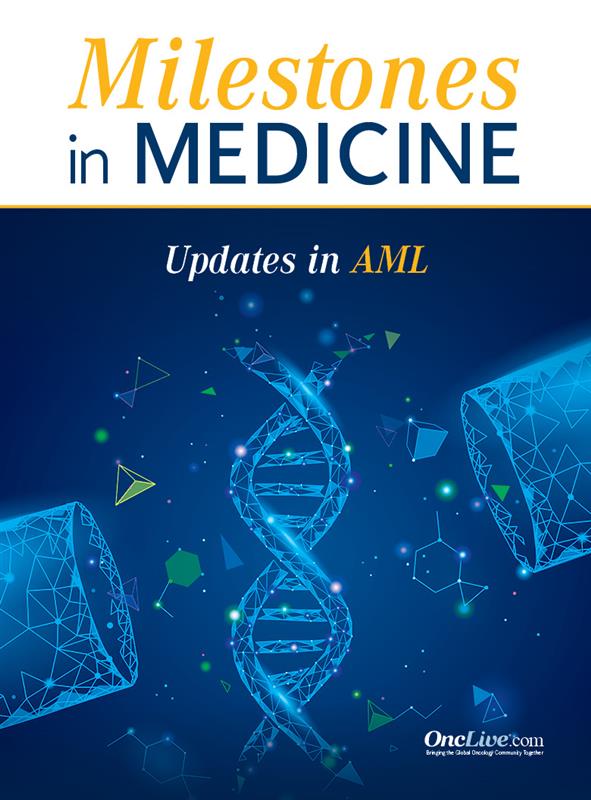E-Selectin Upregulation and Chemo Combinations Among Recent Developments in AML
E-selectin has emerged as a viable target in acute myeloid leukemia, and agents like uproleselan have the potential the increase AML cells’ sensitivity to chemotherapies such as cladribine plus low-dose cytarabine.
Tapan M. Kadia, MD

E-selectin has emerged as a viable target in acute myeloid leukemia (AML), and agents like uproleselan (GMI-1271) have the potential the increase AML cells’ sensitivity to chemotherapies such as cladribine plus low-dose cytarabine, according to Tapan M. Kadia, MD. He also stressed the importance of testing for minimal residual disease (MRD) negativity to determine optimal treatments for patients throughout their disease.
“The biggest key is to make sure that we are able to get uniform MRD across practices in the US and internationally, so we can validate MRD and have a certain measure of what MRD negativity is and then act on that,” Kadia said in an interview with OncLive®.
In an interview with OncLive®, Kadia, an associate professor in the department of leukemia in the Division of Cancer Medicine at The University of Texas MD Anderson Cancer Center, discussed the rationale behind targeting E-selectin, new tools for detecting MRD negativity, and other targets on the horizon in AML, including MCL1, CDK9, and menin.
OncLive®: MRD negativity can lead to better transplant outcomes for patients with AML. What are the clinical benefits of MRD testing?
Kadia: MRD testing is becoming increasingly important and prominent in the treatment of AML. Traditionally, we have used the criteria of complete remission, which is a morphologic diagnosis where we look under the microscope for less than 5% blasts and recovery of the blood counts.
Although those patients are in complete remission with less than 5% blasts and good hematopoiesis, there is still a significant burden of disease left that we may not be able to detect with our eyes, but that can be detected now with newer tools. Among those tools is flow cytometry, which is looking at surface markers, and multiparameter flow cytometry, which allows us to detect MRD down to the level of 1 in 1000 cells.
Other techniques are now being developed. One is called real-time quantitative PCR [polymerase chain reaction], where we can detect certain transcripts down to sometimes 1 in 10,000, or even 1 in 100,000 transcripts. This is limited to a specific subset of AML that has those transcripts with assays that [these tests] can quantify. The next generation after that is next-generation sequencing [NGS], where we can detect certain mutations that were present in the original leukemia to see if they’re still detectable later.
Among the mutations that are useful in detecting MRD, though, only 1 has been validated by quantitative NGS, which is the NPM1 mutation. Residual disease at the end of induction and at the end of consolidation can predict overall outcomes. Persistent MRD at the end of induction or at the end of consolidation predicts for worse relapse-free survival and worse overall survival [OS]. Clearly, these are prognostic.
In fact, if MRD is still present at these time points, those patients would benefit from an allogeneic stem cell transplant. This is a way to dynamically assess risk and allocate patients to stem cell transplant or not.
[Recent data also shows the importance of] eradicating [disease] or achieving MRD negativity prior to transplant, because the patients who have persistent, detectable MRD prior to transplant may have slightly worse outcomes than those who have MRD-negative disease. That makes sense, as the deeper the response, the better the outcome will be after transplant.
There was a nice abstract at the [2022 ASCO Annual Meeting] looking at molecular MRD, which found that NPM1 and FLT3 were prognostic, but mutations like IDH1 and IDH2 were not prognostic prior to transplant. That’s how we assess MRD.
Within AML, E-selectin has emerged as a potential viable target within these patients. What is known so far about this marker, and what are some of the efforts being made to potentially target it with some of these agents?
E-selectin is a marker that’s present in the microenvironment. The microenvironment is the neighborhood where the leukemia cells reside within the bone marrow. When the leukemia cells bind to E-selectin, the E-selectin, which is [a protein] that binds the leukemia cells, provides protection. It activates cell survival and growth pathways, and it promotes a resistance to chemotherapy in AML. This neighborhood signals through E-selectin to provide protection to the leukemia cells in that niche.
The idea is, if we can disrupt that interaction or have something that binds E-selectin to prevent it from binding to the AML cells and providing the signal, then we can potentially make the AML cells more sensitive to chemotherapy. Therefore, patients will have better outcomes, better response rates, and better long-term survival. [We would] essentially be sensitizing these cells by blocking that interaction. One of the drugs that’s been developed is uproleselan, which is a small-molecule [antagonist] of E-selectin, with the rationale to block this interaction.
What is uproleselan’s mechanism of action, and how does it differ from other available agents for these patients?
Uproleselan is the only agent that targets E-selectin. It works differently from other agents in AML like BCL2 inhibitors, FLT3 inhibitors, IDH1 inhibitors, or IDH2 inhibitors, because those target the AML itself, whereas [uproleselan targets] the interaction of the AML cell with the microenvironment. Sometimes [AML treatments] upregulate E-selectin, allowing even more target expressed on the AML cell to be blocked by [the AML drugs].
Uproleselan works in a different way, because it promotes less cell survival signaling for the leukemia cell. It promotes some blocking, and it will hopefully increase the level of apoptosis within the leukemia cell when exposed to chemotherapy. It’s been studied in some clinical trials after initial phase 1 trials.
A phase 1/2 trial [NCT02306291] looked at patients with both newly diagnosed and relapsed/refractory AML. Those with relapsed/refractory AML were treated with uproleselan combined with MEC [mitoxantrone, etoposide, and cytarabine]. [This trial] found that the recommended phase 2 dose was 10 mg/kg. The remission rate was 41%. [In total,] 69% of the patients who had achieved remission were MRD negative at the time of response, which is good for a relapsed/refractory setting, with a median OS of 8.8 months.
[Those findings were] not bad. There were also patients within that trial who were treatment-naïve and treated with uproleselan combined with 7 + 3 chemotherapy, which, in many places, is the standard frontline approach. [Notably,] there were adverse features in the AML. [In the newly diagnosed patients,] the CR rate was 72%, and the median OS was 12.6 months.
Those are the 2 big trials that have led to ongoing [phase 3] trials of uproleselan in AML.
What is the rationale for combining uproleselan with chemotherapy-based regimens?
Chemotherapy is the standard approach for treating AML. It kills the cancer cells. A fraction of these cancer cells are resistant to chemotherapy. One of the mechanisms of resistance is the interaction between E-selectin and the microenvironment. Interrupting this interaction by binding E-selectin and preventing its interaction with the microenvironment can make these cells more sensitive to the chemotherapy that is being given. The idea is to [amplify the effect of] chemotherapy.
What other combinations with uproleselan could have potential efficacy?
[The phase 1b/2 TS-AML study (NCT04848974) is investigating] a combination of cladribine plus low-dose cytarabine plus uproleselan. This combination is for patients who have treated secondary AML.
There is a group of patients who had prior myelodysplastic syndrome [MDS], who were treated with hypomethylating agents [HMAs] such as azacitidine or decitabine. That’s the standard therapy for MDS. Ultimately, though, these treatments are not curative, and these patients will progress from MDS to AML. When they progress, it’s called treated secondary AML, which is a secondary AML that has been previously treated for MDS.
The issue is that the outcomes of these patients are horrendous. Their median survival is in the range of 4 to 6 months, and their response rate to standard therapies is dismal. There are no good options except transplant, but the disease needs to [be controlled first]. We want to look for some chemotherapy approaches that are active.
The other issue is that most of these patients are older because they have MDS. Their de facto median age is [60 years to 70 years], and then they develop AML. They have been treated extensively with HMAs, and they’re older. [These are challenges, as] we cannot give them all intensive chemotherapy.
When we looked back at a subgroup of patients, [those who received] intensive chemotherapy fared the worst. [This treatment] was associated with high rates of early mortality, toxicity, and death, not great survival. This cladribine and low-dose cytarabine regimen is a relatively lower-intensity approach that is well tolerated.
The idea to add uproleselan came from some preclinical knowledge, which the company generated, showing that leukemia blasts that are exposed to HMAs such as azacitidine or decitabine over a period of time significantly upregulate E-selectin, so there’s a ton of target available.
[The hypothesis is,] a patient who has been treated for their MDS for months with HMAs will have upregulation of E-selectin on the surface of those leukemia blasts, and therefore have more target available. [As a result,] we enroll them on uproleselan plus cladribine plus low-dose cytarabine, to target the E-selectin, remove any potential resistance from the microenvironment, and then combine it with cladribine and low-dose cytarabine, therefore sensitizing those cells to the therapy. That’s the overall hypothesis, and I’m excited about it. We’ll hopefully see some good outcomes with this combination.
Beyond E-selectin, what other novel targets are emerging within AML?
There are many great targets; FLT3, IDH1, and IDH2 are out there already. Many inhibitors have been developed and are being developed in those settings. BCL2 inhibitors have been developed. [Regarding apoptosis,] we’re looking at exciting pathways such as MCL1 inhibition, which is a member of the BCL2 family, as well as CDK9 inhibitors, which allow downregulation of MCL1, an anti-apoptotic protein. Those are 2 important targets.
Menin inhibitors, where menin is the target, are potentially active in patients who have MLL-rearranged AML and for patients who have relapsed AML with NPM1 mutations. Those are some important targets and drugs that are being developed, and I look forward to seeing some good responses there.




